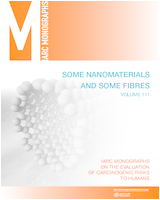NCBI Bookshelf. A service of the National Library of Medicine, National Institutes of Health.
IARC Working Group on the Evaluation of Carcinogenic Risks to Humans. Some Nanomaterials and Some Fibres. Lyon (FR): International Agency for Research on Cancer; 2017. (IARC Monographs on the Evaluation of Carcinogenic Risks to Humans, No. 111.)
5.1. Exposure data
Fluoro-edenite fibrous amphiboles – a new end-member of the calcic amphibole group composed of most fluoro-edenite – have been identified in the volcanic products of Mount Etna near Biancavilla in Sicily, Italy, and represent the first occurrence of amphibole fibres in a volcanic environment; a “fluoro-edenite” compound was also found in the lava dome of the Kimpo volcano, Kumamoto, Japan. Fluoro-edenite is found as prismatic or acicular crystals or as asbestiform (fibrous) fibres.
The composition of samples of the amphibole fibres from Biancavilla included fluoro-edenite (60%), winchite (24%), tremolite (12%), and richterite (4%). The variable chemical composition of fluoro-edenite and the presence of different components complicate the classification of these fibres and the definition of their mineral species.
Fluoro-edenite and the associated fibrous amphiboles from Biancavilla occur naturally, and early environmental investigations identified the source as local quarry products that had been used in building materials for local structures since at least the 1950s. Unpaved roads made from the local quarry products have also been recognized as a primary source for airborne fluoro-edenite fibres.
Comparison of outdoor air samples taken before mitigation efforts were begun in 2000 with those taken in 2013 showed that mean amphibole concentrations have diminished from 1.76 fibres/L to 0.1 fibres/L. Indoor air may also be contaminated from the use of local quarry products in plaster and mortar. Few data are available to determine the occurrence of fluoro-edenite fibres in water supplies in and around Biancavilla other than one study, in which all 10 samples taken from several local wells and springs were reported to contain fluoro-edenite fibres. Analysis of samples of top soil and roadside dust in Biancavilla showed that approximately 90% of samples contained fluoro-edenite fibres.
5.2. Human carcinogenicity data
An excess of mortality from and incidence of mesothelioma has been documented in several surveillance studies in the Biancavilla municipality of Sicily, Italy, where exposure to fluoro-edenite from naturally occurring sources has been found. Although the exposure assessments were essentially ecological in nature, these studies provided strong evidence for a causal association for several reasons. First, the magnitude of the rate ratios for mesothelioma was large and statistically stable, and thus chance is unlikely to explain these findings. Second, most of these cases did not have any history of occupational or environmental exposure to asbestos. Approximately 70–90% of cases of mesothelioma in the general population are believed to be attributable to exposure to asbestos; therefore, the fact that the majority of the cases in Biancavilla had no known exposure to asbestos strongly suggests another local exposure. The excess observed was similar in both sexes and was most prominent in young adults, which strongly indicates an environmental rather than an occupational cause. Finally, the cases were identified through a national surveillance programme using standardized procedures and their diagnoses were based on extensive pathological review; thus biases of ascertainment and diagnosis are unlikely to explain the findings.
The findings for cancer of the lung were much weaker than those for mesothelioma. A modest excess of mortality from cancer of the lung was observed in women and a modest deficit was observed in men, both with wide confidence intervals. The lack of any strong evidence of an effect on cancer of the lung may reflect that, in contrast to mesothelioma, the background rate of lung cancer is high and its causes are multiple. Furthermore, several studies of environmental exposure to asbestos in other countries have also failed to demonstrate an excess of lung cancer. The Working Group considered that the evidence for carcinogenicity in the lung was inadequate because of the small number of studies, the weak indication of an association, and the lack of controls for potential confounding.
5.3. Animal carcinogenicity data
The carcinogenicity of fluoro-edenite fibrous amphibole has been investigated in only one study in experimental animals. Intraperitoneal injection of fibrous fluoro-edenite caused a significant increase in the incidence of mesothelioma in male and female rats. In the same study, intrapleural injection of fluoro-edenite resulted in a high incidence of mesotheliomas in male and female rats relative to historical controls from that laboratory.
5.4. Mechanistic and other relevant data
Fluoro-edenite is biopersistent in the lungs of sheep and is detected in the sputum of exposed humans. In-vitro exposure to fluoro-edenite induces DNA breaks and is associated with the release of cytokines in human epithelial cells and fibroblasts, and murine monocyte-macrophages. The available studies are consistent with the mechanisms proposed for fibre carcinogenicity (see IARC, 2012). Overall, the mechanistic data for the carcinogenicity of fluoro-edenite are moderate.
- Summary of Data Reported - Some Nanomaterials and Some FibresSummary of Data Reported - Some Nanomaterials and Some Fibres
Your browsing activity is empty.
Activity recording is turned off.
See more...
